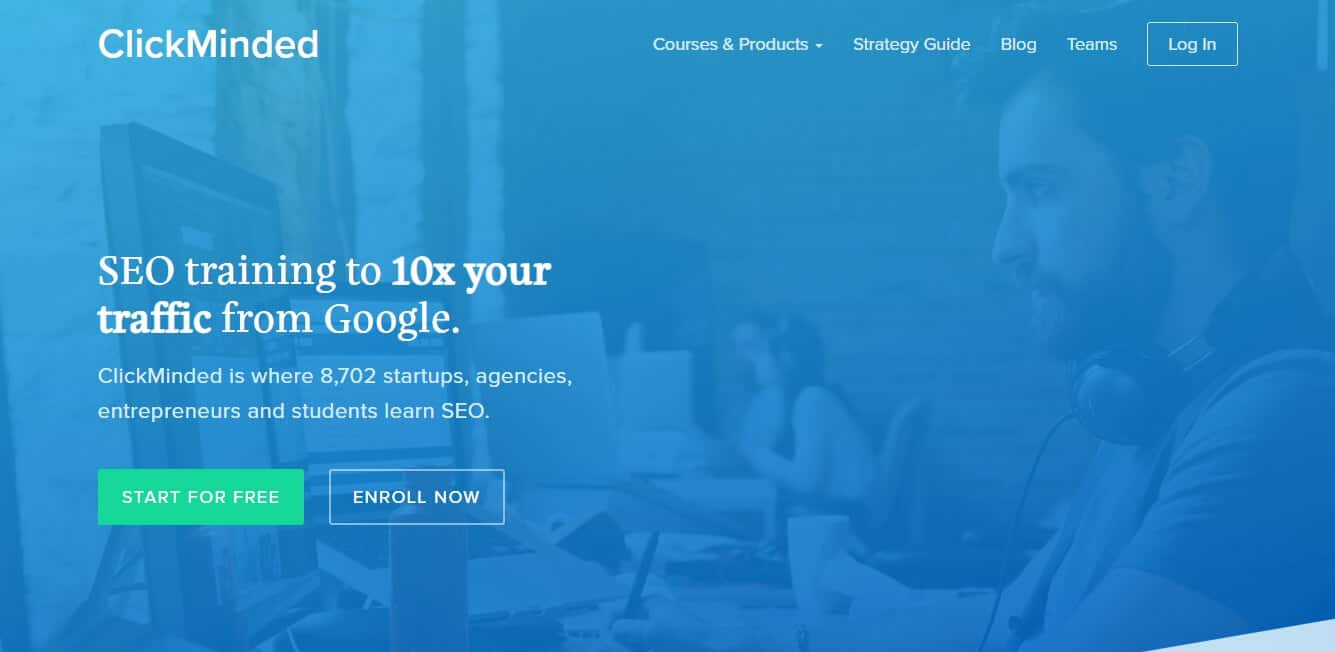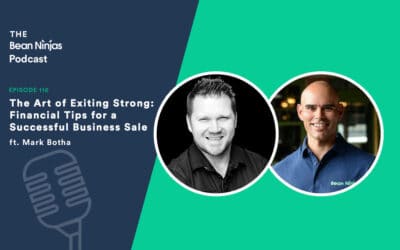
When and how do you bring on a new business partner? Here’s how Tommy did it.
In Episode 53 of the Bean Ninjas Podcast, Bean Ninjas CEO Meryl Johnston talks to Tommy Griffith about bringing on a business partner, and his journey from side hustle to full-time entrepreneur.
When and how do you bring on a new business partner? Here’s how Tommy Griffiths did it. #entrepreneur Share on XThe not-so-Insta-worthy journey of a digital nomad
For Tommy, Clickminded started off as a side project eight years ago. Up until that point, Tommy had been doing SEO for ten years. So launching an online SEO training course was a natural progression.
He managed SEO for two big tech companies in Silicon Valley; PayPal and Airbnb. Also, he started teaching offline SEO workshops to start-ups on the side.
In 2012. he created an online course for Udemy and used this course to train his team at Airbnb.
As Tommy discovered, turning your knowledge into a profitable online course (or courses) can be a great move.
Tommy left San Francisco to go traveling whilst he continued building the business.
“The biggest mistake I made: I gave myself a long time to plan and plot, I really set expectations for myself that were bananas.”
The idea was to expand to seven courses because there’s a massive need for digital marketing training. Some Universities in the US charge $40,000 – $90,000 a year for a masters degree in digital marketing.
Though, this appears to be pointless, because there’s a lot of self-teaching out in the game right now.
So, Tommy filmed a bunch of content, brought it all to Bali to work there and things were looking epic.
“I was so excited, I’m a digital nomad now.”
However, disaster struck…
Tommy was robbed by the police by the second day in Bali, and he got food poisoning. To add insult to injury, it was pouring rain during the filming for his courses and that nearly ruined all the audio.
Everything needed to be recorded again!
Tommy spent $15,000 on this process, and then the unthinkable happened…
He left his hard drive with all the recorded content on a bus!
Thankfully, he got the hard drive a day later.
“One week into my digital nomad-ing, I was thinking about how I had the best job in San Francisco, my friends are there, breakfast, lunch, and dinner paid for, Airbnb credit to travel every quarter…And, I’m looking at the sky like what did I do? Why am I here? Why did I give this up? It was going backward, like going deep into hell for no reason at all.”
Learning to sacrifice – How Tommy juggled a social life, job, and a side-hustle
The side-hustle remained a side-hustle because Tommy wasn’t really ready. Clickminded was probably his tenth attempt at business, maybe fifteenth.
“If you want someone to mess everything up, and drive a website into the ground, call me up because I’m great at it.”
Tommy spent years in learning, practicing and working on SEO, that’s incredibly nerdy, and he would never tell anyone at the bar that.
“The key is to have friends that hate you and a girlfriend that hates you. There’s no secret to this, you have to pick things, and the other things start to decay and die.”
You have to learn to relentlessly say ‘no’ to a lot of social defaults in order to do these things right.
“Friends’ birthdays, picnic in the park…social life definitely did suffer. If you’re a loud, obnoxious guy, who likes to be in the center of attention, rally everyone together, and you suddenly stop showing, it infuriates people.”
The sacrifice needs to be made, and not everybody is going to understand.
Also, while talking and updating people about his business, Tommy got in a social experiment. Seems that people always want both ways, but actions never line up with words.
“I’m definitely going to do that, I’ll start tomorrow, and then the next thing is you see them on their eleventh beer at the bar, completely passed out.”
Most of those people are in the same job, in the same city, hanging out with the same friends, and that’s not necessarily bad.
“It was easy for me to wake up on Saturday mornings and go to work, I really liked it.”
Related: Burning the Boats: Going All-In on a Side Project
How Tommy found his business partner
The big turning point for Tommy’s business was bringing on a business partner as co-founder.
“Not only is this not working, but I’m no longer confident in my own ability to do this, I want to bring someone else.”
Since he always used an apprenticeship model for his business, Tommy always had an apprentice helping him out.
“Choosing a business partner from your co-workers, either those you currently work with or from a previous job, can be a great way to find someone to start your business with. Not only is it convenient, but choosing a business partner that you have already worked with can give you a huge advantage over picking a partner you haven’t worked with yet.” – Briana Morgaine, How to Find a Business Partner
His previous apprentice, Eduardo Yi, was amazing, and they had worked together for about six months.
So, Tommy e-mailed Eduardo saying that he wants to go huge with Clickminded but had no idea what he was doing. On the other hand, Eduardo was really good at setting strategies for the business.
Eduardo ended up being Clickminded’s customer avatar.
This was a ‘faux pas’ in the entrepreneurial world because Eduardo’s vision for Clickminded was actually much stronger than Tommy’s.
“I put him in the driver’s seat and got out of his way.”
Related podcast: Leadership and communication from management
Eduardo’s transition to full-time business partner
Eduardo had a job that he loved in New York at that point, so he worked on Clickminded part-time.
Tommy and Eduardo re-created, re-filmed, re-did the entire product and re-launched it on a webinar. Since they already had a massive audience, the webinar generated a tone of sales, users, and interests.
Eduardo made a plan for himself to transition to Clickminded full-time.
“The business isn’t big enough to support both of us yet, let’s do another launch of all of the other products and grow the business to the point where it’s so big that I have to leave.”
Once they created a successful product, they sat down to set some goals and bring them on full time.
It started as a small team, trying out new things. The launch went so well that they got way too confident, so the next six months were a disaster.
The secret is that Tommy was working on this business really long, so he gained people’s trust. All they did then was launch new products to former users.
“It’s not that I was particularly good at what I was doing, it’s just that I was doing it very badly for a very long time.”
Tommy didn’t know about the principle of a thousand-day rule i.e. you need to work on your side project for about a thousand days for it to hit your current salary.
Related podcast: Turning Your Side Hustle into a Full-Time Job – Christopher Silvestri
When Tommy counted the actual number of days he’d been working on his business, the thousand-day principal turned out scarily accurate.
“It has to work when you’re working on it that long.”
“When you first do it, you’re going to be absolutely terrified, mortified, waking up in the cold sweat every day. I’m sorry it’s going to happen, no matter what, but once you get a little bit of a breathing room it’s really fun to work on stuff that might not always have a point.”
How to identify a bad business partner before it’s too late
Tommy’s approach to finding and bringing onboard Eduardo as co-founder worked out well. However not all business partnerships work out so well.
So make sure that you’re across the 6 ways to identify a bad business partner before you jump into business with them. It’s also a wise move to set up a co-founder agreement early on as that can save you a lot of pain, money and confusion.
Related: From 2 Founders to 1: Lessons Learned About Business Partnerships
For more tips on choosing a business partner, check out the following infographic.

(source:www.entrepreneur.com)
Listen in to know more about how to bring on a new business partner
Meryl and Tommy Griffith discuss:
- Making time for a side-hustle
- The process of turning a side-hustle into a full-time business
- What to do when things go wrong, and Tommy’s experience as a digital nomad
- The sacrifices you need to make to achieve your goals
- The role of timing for when to bring on a business partner
- Tips for making sure that you’ve got the right business partner (co-founder) for your business
Resources mentioned in this episode
- ClickMinded
- SEO Strategy Guide
- Digital Marketing Strategy Guide
- SEO Checklist
- Connect with Tommy via Twitter
Enjoying the show? Please subscribe & review in itunes
If you enjoyed listening to this episode and you want a really easy way to support the podcast, why don’t you head over to iTunes and leave us a quick rating or even a review? We would also love to hear what you thought of today’s episode.
Looking for an easy way to get there? Just go to beanninjas.com/podcastreview and that should open up iTunes on your computer. We read all your reviews, and it really helps other people to discover the show. Your support is very much appreciated.






